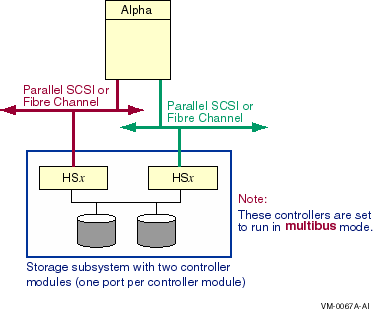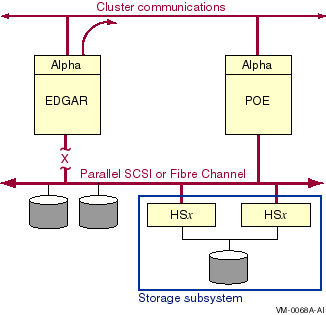HP OpenVMS Systems Documentation |
Guidelines for OpenVMS Cluster Configurations
5.3 Choosing Disk Performance OptimizersEstimating your anticipated disk performance work load and analyzing the work load data can help you determine your disk performance requirements.
You can use the Monitor utility and DECamds to help you determine which
performance optimizer best meets your application and business needs.
Performance optimizers are software or hardware products that improve storage performance for applications and data. Table 5-3 explains how various performance optimizers work.
1The MSCP server makes locally connected disks to which it has direct access available to other systems in the OpenVMS Cluster. Reference: See Section 10.8 for more information about how these performance optimizers increase an OpenVMS Cluster's ability to scale I/Os.
Some costs are associated with optimizing your storage subsystems for higher availability. Part of analyzing availability costs is weighing the cost of protecting data against the cost of unavailable data during failures. Depending on the nature of your business, the impact of storage subsystem failures may be low, moderate, or high.
Device and data availability options reduce and sometimes negate the
impact of storage subsystem failures.
Depending on your availability requirements, choose among the availability optimizers described in Table 5-4 for applications and data with the greatest need.
5.5 CI-Based Storage
The CI interconnect provides the highest OpenVMS Cluster availability
with redundant, independent transmit-and-receive CI cable pairs. The CI
offers multiple access paths to disks and tapes by means of dual-ported
devices between HSC or HSJ controllers.
The following controllers and devices are supported by the CI interconnect:
5.6 DSSI StorageDSSI-based configurations provide shared direct access to storage for systems with moderate storage capacity. The DSSI interconnect provides the lowest-cost shared access to storage in an OpenVMS Cluster.
The storage tables in this section may contain incomplete lists of
products.
DSSI configurations support the following devices:
Reference: RZ, TZ, and EZ SCSI storage devices are
described in Section 5.7.
The Small Computer Systems Interface (SCSI) bus is a storage
interconnect based on an ANSI industry standard. You can connect up to
a total of 8 or 16 nodes (3 of which can be CPUs) to the SCSI bus.
The following devices can connect to a single host or multihost SCSI bus:
The following devices can connect only to a single host SCSI bus:
5.8 Fibre Channel Based Storage
The Fibre Channel interconnect is a storage interconnect that is based
on an ANSI industry standard.
The HSG and HSV storage controllers can connect to a single host or to
a multihost Fibre Channel interconnect. For more information about
Fibre Channel hardware support, see Section 7.2.
Host-based storage devices can be connected locally to OpenVMS Cluster member systems using local adapters. You can make this locally connected storage available to other OpenVMS Cluster members by configuring a node as an MSCP server.
You can use local adapters to connect each disk to two access paths
(dual ports). Dual porting allows automatic failover of disks between
nodes.
Locally connected storage devices attach to a system's internal bus. Alpha systems use the following internal buses:
VAX systems use the following internal buses:
5.9.2 Local AdaptersFollowing is a list of local adapters and their bus types:
Chapter 6
|
OpenVMS Alpha Version 7.3-1 introduced support for failover between local and MSCP served paths to SCSI disk devices. This type of failover does not apply to tape devices. This capability is enabled by the MPDEV_REMOTE system parameter setting of 1, which is the default setting. This SCSI multipath feature may be incompatible with some third-party disk caching, disk shadowing, or similar products. HP advises that you not use such software on SCSI devices that are configured for multipath failover (for example, SCSI devices that are connected to HSZ70 and HSZ80 controllers in multibus mode) until this feature is supported by the producer of the software. See Section 6.2 for important requirements and restrictions for using the multipath SCSI function. Note that the Fibre Channel and parallel SCSI interconnects are shown generically in this chapter. Each is represented as a horizontal line to which the node and storage subsystems are connected. Physically, the Fibre Channel interconnect is always radially wired from a switch, as shown in Figure 7-1. Parallel SCSI can be radially wired to a hub or can be a daisy-chained bus. The representation of multiple SCSI disks and SCSI buses in a storage subsystem is also simplified. The multiple disks and SCSI buses, which one or more HSZx, HSGx, or HSVx controllers serve as a logical unit to a host, are shown in the figures as a single logical unit. |
The following topics are presented in this chapter:
A multipath SCSI configuration provides failover from one path to a device to another path to the same device. Multiple paths to the same device increase the availability of that device for I/O operations. Multiple paths also offer higher aggregate performance. Figure 6-1 shows a multipath SCSI configuration. Two paths are configured from a computer to the same virtual storage device.
Multipath SCSI configurations for disk devices can use either parallel SCSI or Fibre Channel as the storage interconnect, as illustrated by Figure 6-1. Multipath SCSI configurations for tape devices can use only Fibre Channel as the storage interconnect.
Two or more paths to a single device are called a multipath set. When the system configures a path to a device, it checks for an existing device with the same name but a different path. If such a device is found, and multipath support is enabled, the system either forms a multipath set or adds the new path to an existing set. If multipath support is not enabled, then no more than one path to a device is configured.
The system presents a multipath set as a single device. The system selects one path to the device as the "current" path, and performs all I/O over this path until there is a failure or the system manager requests that the system switch to another path.
Multipath SCSI support provides the following types of failover:
Direct SCSI to direct SCSI failover requires the use of multiported
SCSI devices. Direct SCSI to MSCP served failover requires multiple
hosts per SCSI bus, but does not require multiported SCSI devices.
These two failover types can be combined. Each type and the combination
of the two are described next.
6.1.1 Direct SCSI to Direct SCSI Failover
Direct SCSI to direct SCSI failover can be used on systems with multiported SCSI devices. The dual HSZ70, the HSZ80, the HSG80, the dual MDR, and the HSV110 are examples of multiported SCSI devices. A multiported SCSI device can be configured with multiple ports on the same physical interconnect so that if one of the ports fails, the host can continue to access the device through another port. This is known as transparent failover mode and has been supported by OpenVMS for disk devices since Version 6.2.
OpenVMS Version 7.2 introduced support for a new failover mode in which the multiported disk device can be configured with its ports on different physical interconnects. This is known as multibus failover mode.
The HSx failover modes are selected by HSx console commands. Transparent and multibus modes are described in more detail in Section 6.3.
Figure 6-1 is a generic illustration of a multibus failover configuration.
Configure multiple direct SCSI paths to a disk device only when multipath support is enabled on all connected nodes, and the HSZ/G is in multibus failover mode. |
The two logical disk devices shown in Figure 6-1 represent virtual storage units that are presented to the host by the HSx controller modules. Each logical storage unit is "on line" to one of the two HSx controller modules at a time. When there are multiple logical units, they can be on line to different HSx controllers so that both HSx controllers can be active at the same time.
In transparent mode, a logical unit switches from one controller to the other when an HSx controller detects that the other controller is no longer functioning.
In multibus mode, as shown in Figure 6-1, a logical unit switches from one controller to the other when one of the following events occurs:
Figure 6-1 Multibus Failover Configuration

Note the following about Figure 6-1:
The multibus configuration offers the following advantages over transparent failover:
OpenVMS provides support for multiple hosts that share a SCSI bus. This is known as a multihost SCSI OpenVMS Cluster system. In this configuration, the SCSI bus is a shared storage interconnect. Cluster communication occurs over a second interconnect (LAN, DSSI, CI, or MEMORY CHANNEL).
Multipath support in a multihost SCSI OpenVMS Cluster system enables failover from directly attached SCSI storage to MSCP served SCSI storage, as shown in Figure 6-2.
Figure 6-2 Direct SCSI to MSCP Served Configuration With One Interconnect

Note the following about this configuration:
Multipath support in such a multihost SCSI OpenVMS Cluster system also enables failover from MSCP served SCSI storage to directly attached SCSI storage. For example, the following sequence of events can occur on the configuration shown in Figure 6-2:
In this document, the capability to fail over from direct SCSI to MSCP served paths implies the ability to fail over in either direction between direct and served paths. |
| Previous | Next | Contents | Index |